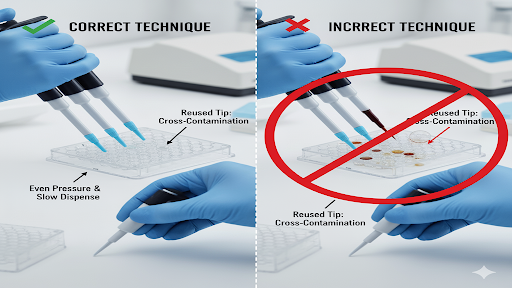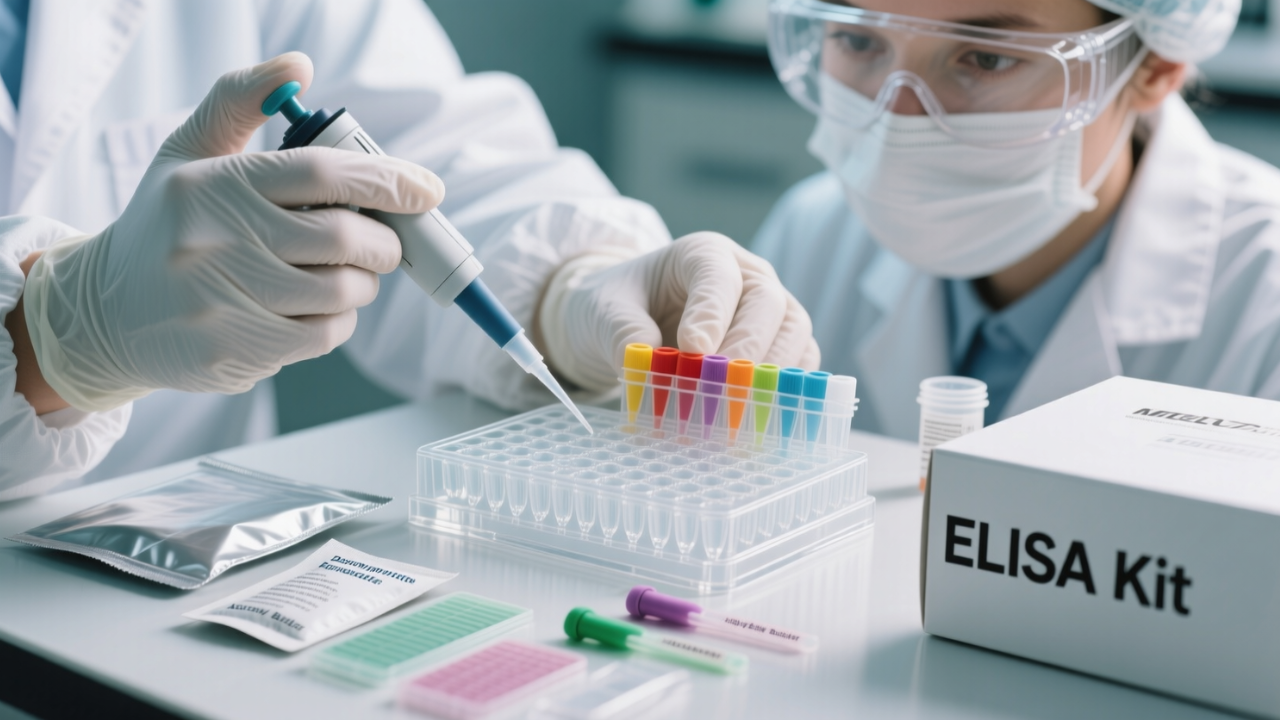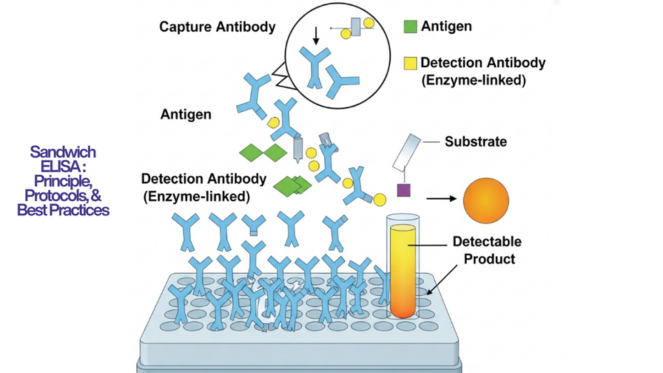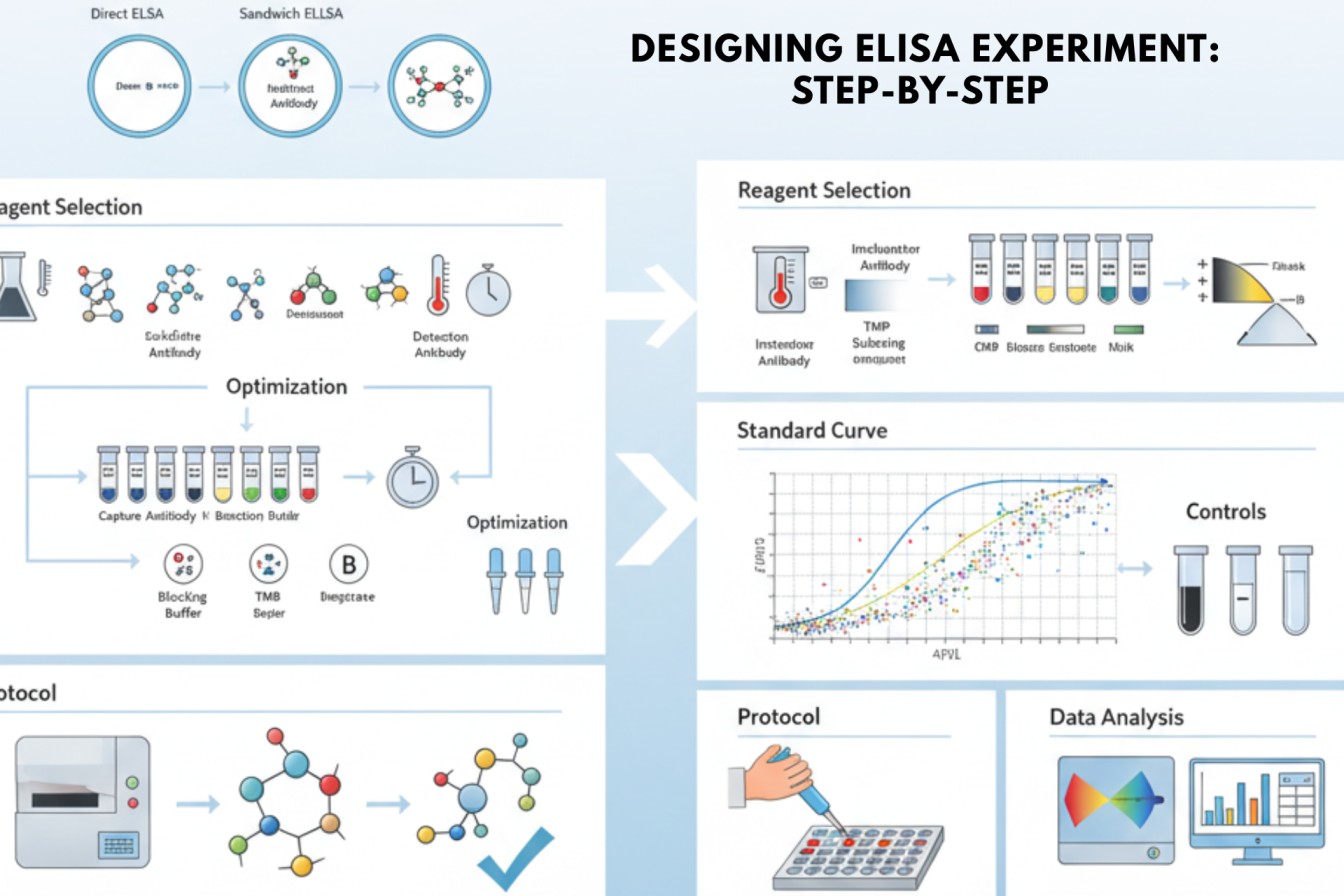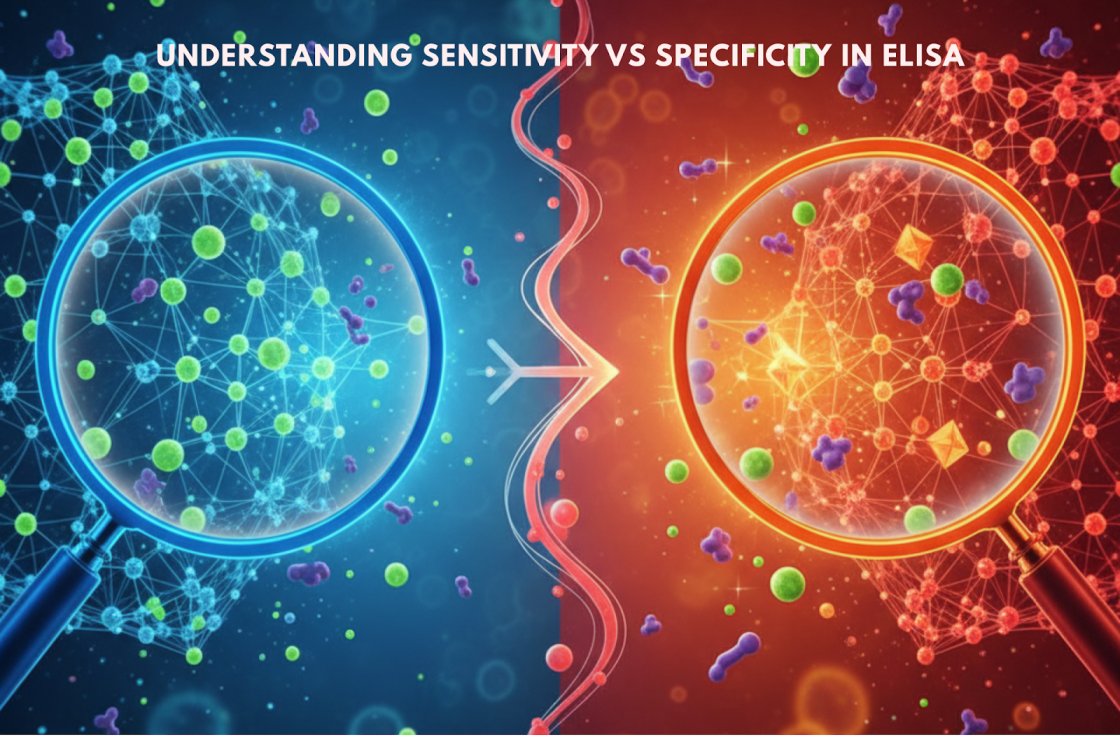Common ELISA Mistakes and How to Avoid Them
In this Article
- Mistake 1: High Background Signal
- Mistake 2: Weak or No Signal
- Mistake 3: Cross-Reactivity and Non-Specific Binding
- Mistake 4: Pipetting Mistakes and Cross-Contamination
- Mistake 5: Incubation Conditions and Edge Effects
- Mistake 6: Reagent Handling and Storage Problems
- Mistake 7: Calibration and Standard Curve Errors
- Final Words
All of the products listed in AAA Biotech’s catalog are strictly for research-use only (RUO).
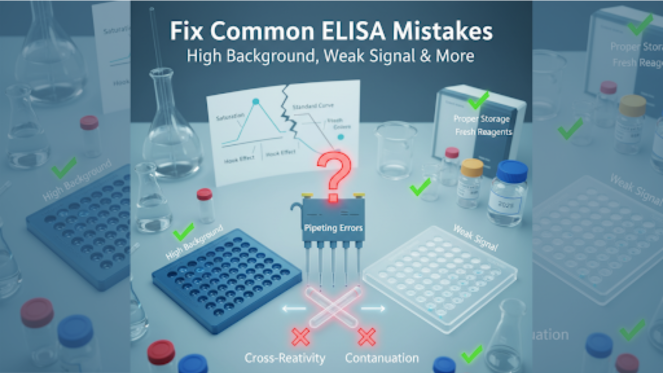
Enzyme-Linked Immunosorbent Assays (ELISAs) are one of the most useful tools in life science research due to their sensitivity and specificity. However, it is this very sensitivity that can make working with ELISA difficult if proper technique and protocols are not followed.
Therefore, it becomes crucial for students and researchers to understand and be aware of some of the most common ELISA mistakes and learn how to avoid them in order to ensure reliable, reproducible, results.
Key Takeaways
- High background signal and weak signal are two of the most common issues encountered in ELISA.
- Using affinity-purified and monoclonal antibodies can help.
- If using a secondary antibody, choose one that is cross-adsorbed against the sample's host species.
- Pipetting errors must be avoided to ensure accurate and reproducible results.
Mistake 1: High Background Signal
One of the most commonly encountered ELISA problems is a high background signal. This is when even the blank or negative-control wells show a substantially elevated signal.
Now, there are many reasons why this happens; however, incomplete blocking or insufficient washing are typically going to be the reasons in most cases. If the plate’s free binding sites are not fully blocked, antibodies or other proteins can stick directly to the plate (when they should not), potentially resulting in a non-specific high signal. Similarly, inadequate washing between steps can leave residual reagents that continue to react and elevate the signals. Although not as common, using higher concentrations of detection antibody or conjugate can potentially exacerbate this problem.
How to Avoid The “High Background Signal” Problem
If you’ve already figured out the reasons behind the high background signal, chances are you already know how to fix it. If you’re unsure of the reason, the best course of action is to perform a thorough blocking step and verify that the blocking buffer doesn’t introduce cross-reactivity. Secondly, make sure to perform the wash steps thoroughly (3-5 washes per cycle is typical) with a proper wash buffer.
Mistake 2: Weak or No Signal
On the other end of the common ELISA mistakes, is getting little-to-no detectable background signal. What this means is that the assay isn’t detecting the target as it should, leading to false negatives or very low sensitivity.
Common reasons why your ELISA might yield a weak signal are insufficient detection reagents or suboptimal incubation conditions. It should also be noted that incubation times also affect the intensity of the background signal (i.e., too short of incubation duration will mean the reagents will not reach the proper temperature, and subsequently result in a weak signal).
A less common reason, but still certainly one to consider, is that one or more of the reagents could have lost their activity (this could be due to many causes such as being expired or that they may have been stored at improper conditions).
How to Avoid Critically-Weak Background Signal
Compared to the previous section on reducing the background signal strength, fixing a weak background signal is easier. The important thing to remember is to ensure adequate antibody concentration and adhere to the recommended incubation time and temperature. Secondly, before the test, check if your reagents are fresh and remain active.
Mistake 3: Cross-Reactivity and Non-Specific Binding
Although ELISAs rely on highly specific antigen-antibody interactions, cross-reactivity can still occur and is an issue faced by many students and researchers, often resulting in false positives.
Why does this happen? Usually, it stems from antibodies recognizing similar epitopes existing on off-target proteins (such as a polyclonal antibody material being able to bind to various closely related proteins in the same sample). While it may seem like a rare occurrence, it is a well-known and feared pitfall in indirect ELISA formats (the enzyme-linked secondary antibody can sometimes bind to proteins in the sample itself instead of solely to the primary antibody that it was intended to be exclusive for, especially if those sample proteins come from the same host species).
How to Minimize Cross-Reactivity and Non-Specific Binding
Use affinity-purified and monoclonal antibodies with known specificity for the target. If your situation requires the use of a secondary antibody, choose one that has been adsorbed or cross-adsorbed to remove reactivity against the species that your sample originates from.
NOTE: When buying high-affinity antibodies, always choose a reputable source like AAA Bio.
Mistake 4: Pipetting Mistakes and Cross-Contamination
Performing a successful ELISA experiment is highly dependent on good pipetting technique. Therefore, pipetting errors, such as inaccurate volume delivery, not mixing reagents uniformly, or carryover contamination between wells, can lead to highly variable and non-replicable results.
One common mistake (frequently overlooked) is reusing pipette tips between different samples or reagents to save time or resources. While it may not seem like a huge issue, the problem is that even a small residue left in a tip can contaminate the next well, and the resulting cross-contamination can blurs the distinction between samples and significantly skew the results.
A second common mistake is inconsistent technique. It can be anything, like pipetting at different speeds or angles that may introduce bubbles or inconsistent volumes into the wells. In the same vein, if multi-channel pipettes are used improperly, the liquid has the potential to not be evenly distributed across all channels.
How to Correct Pipetting Mistakes and Cross-Contamination
To combat these issues, establish a disciplined pipetting protocol. Always use fresh pipette tips for each sample and each reagent transfer. This way you can eliminate carryover between wells and ensure sample integrity. Also, make sure to calibrate your pipettes regularly and handle them properly with the following suggestions:
- Steady pressure on the plunger
- Slow aspiration/dispensing to avoid bubbles
- Consistent technique across all wells
It’s also a good habit to get into to actually quickly perform a visual check that volumes appear equal in every well, as an uneven fill might indicate a pipetting slip that should be corrected immediately.
Mistake 5: Incubation Conditions and Edge Effects
Since ELISA reactions are highly time- and temperature-sensitive, even the slightest inconsistent incubation condition can be a source of error. Among the errors caused in this manner, the “edge effect” is a particularly notorious phenomenon where wells at the perimeter of the 96-well plate show markedly different signals than the interior wells.
How to Avoid Edge Effects?
To minimize incubation-related variability and edge effects, keep strict consistency in the timing of steps and the environmental conditions each step is performed under. Use a timer for each incubation step and add reagents in a systematic order (column by column, or with a multi-channel pipette row by row) such that each well gets as close to the same incubation duration as possible.
Also, avoid placing ELISA plates near potential sources of drafts or near the edges of an incubator where temperature may fluctuate.
Lastly, never stack plates during incubation.
Mistake 6: Reagent Handling and Storage Problems
Poor reagent handling and storage are sometimes a hidden source (usually overlooked) for many ELISA issues experienced by scientists.
Improper storage of the ELISA kit can sometimes also lead to expired/degraded reagents being used in the test, which can result in suboptimal or inconsistent signal production, as the standards could have fully/partially broken down or the kit’s antibodies have lost binding activity.
How to Properly Store Reagents?
To avoid these pitfalls, always follow the storage guidelines for each reagent, (i.e., keep enzymes in the dark at 4°C and aliquot proteins for single-use to avoid freeze-thaw cycling).
Also, when you open a new ELISA kit, note the lot numbers of each component and, if possible, stick to using matched components together.
Lastly, never assume a reagent is good. Always check expiration dates and inspect reagents for any signs of contamination (cloudiness or microbial growth in buffers, etc.).
Mistake 7: Calibration and Standard Curve Errors
One common error is making a mistake during the serial dilution of the standards. Such errors will lead to an erroneous standard curve that will invariably incorrectly quantify sample concentrations or fail linearity checks.
Another issue is saturation and the “hook effect.” In a sandwich ELISA, extremely high concentrations of the target analyte can paradoxically produce a lower signal (the hook effect) because the excess analyte saturates both antibody components and prevents sandwich formation.
How to Avoid Calibration and Standard Curve Errors
To fix this, make sure to prepare standards carefully and double-check each dilution step when making the standard’s dilution series.
To address the hook effect, dilute your samples that are likely to have very high analyte levels and, if possible, test multiple dilutions.
Tip: Perform a pilot assay with a wide range of dilutions for an expectedly high sample to see if the signal starts decreasing at high concentrations, and if so, you’ve detected a hook effect that should be diluted out further.
Final Words
To conclude, most ELISA errors stem from causes that are entirely preventable with good laboratory practices. By using proper blocking and washing, double-checking reagent preparation and storage, maintaining consistent technique and timing, and incorporating appropriate controls, you can troubleshoot and prevent the majority of ELISA problems before they impact your project’s results.
Faq's
What is the main cause of high background signals in an ELISA?
Incomplete blocking of the plate's free binding sites or insufficient washing between assay steps.
Why might an ELISA yield a weak or no signal (false negative)?
This is often due to insufficient detection reagents, suboptimal incubation times/temperatures, or the use of expired/inactive reagents.
How can I prevent high background signals?
Perform a thorough blocking step, ensure the blocking buffer is non-cross-reactive, and use a proper wash buffer with a schedule of 3-5 washes between steps.
What is cross-reactivity in ELISA, and how does it lead to false positives?
Cross-reactivity occurs when antibodies recognize similar epitopes on proteins other than the target protein that they were intended to be specific for the epitope of, or when a secondary antibody binds non-specifically to sample proteins, leading to a signal that isn't from the target.
How can I minimize cross-reactivity?
Use affinity-purified and monoclonal antibodies with known specificity. If using a secondary antibody, choose one that has been cross-adsorbed against the sample’s species.
How can pipetting mistakes and cross-contamination be avoided?
Always use fresh pipette tips for each transfer, calibrate pipettes regularly, and maintain a consistent, proper technique (steady pressure, slow aspiration/dispensing).
What are the best practices for storing ELISA reagents?
Follow specific storage guidelines (e.g., 4°C in the dark for enzymes), aliquot proteins/reagents to prevent freeze-thaw cycles, and always check expiration dates and signs of contamination.
What is the "hook effect" in a standard curve, and how can it be fixed?
The hook effect is a paradoxical lower signal observed for an extremely high analyte concentration because the excess analyte saturates both capture and detection sites, preventing proper sandwich formation. Fix it by diluting high-analyte samples and testing multiple dilutions.

